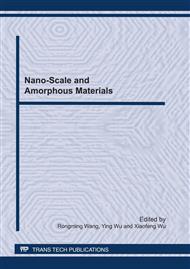p.41
p.45
p.51
p.57
p.62
p.69
p.74
p.80
p.85
Effects of Deformation and Aging on Microstructure and Performances of CuSn10Zn2FeCo Alloy by Centrifugal Casting
Abstract:
CuSn10Zn2FeCo alloy has been fabricated by using vacuum melting and centrifugal casting technology. The effect of deformation and aging on microstructure and mechanical properties of the alloy is investigated by SEM, XRD and TEM. The results show that Cu-Sn-Zn-Fe-Co alloy reinforced with iron nanoparticles has been fabricated at condition of enforced flow, most of them with diameters form 2 to 20 nm, with strong strengthening effect. The precipitation particles have coherent or semi-coherent relationship to the copper matrix. The optimum cold rolling and heat treatment processing is proved to be solution treatment at 1023-1070K for 1.5h followed by 40% cold rolling deformation then aged at 673K for 4h, under which the tensile strength 635 MPa, yield strength 505 MPa and elongation 20% can be obtained. The amounts of hard brittle phase significantly reduce and the segregation of Sn element eliminates. The high strength of the alloy can be explained by substructure strengthening due to cold rolling and precipitation strengthening of the iron nanoparticles and other metallic compounds such as CoCu2Sn phase, the strengthening mechanism obeys Orowan mechanism.
Info:
Periodical:
Pages:
62-68
Citation:
Online since:
June 2011
Authors:
Price:
Сopyright:
© 2011 Trans Tech Publications Ltd. All Rights Reserved
Share:
Citation:


